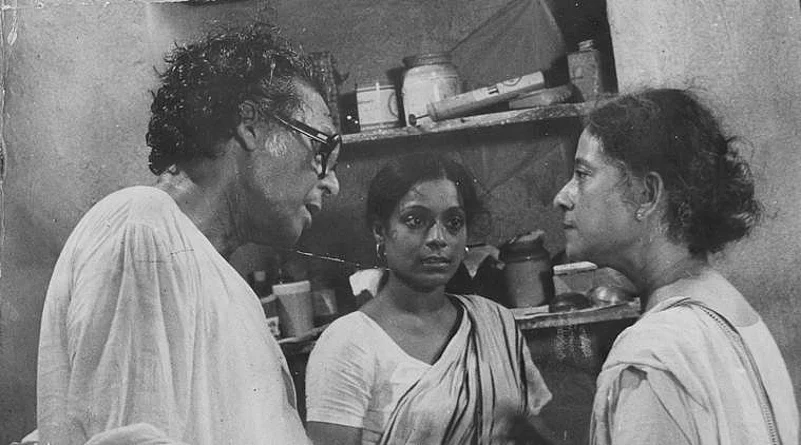Cannes, Berlin, Venice – the trio of epitome of film festivals still considered as the place where the best of films of an era are nurtured and introduced to the world. At a time when Indian filmmakers struggle to get into the competition sections of these film festivals, there was a man who started the New Wave Movement in India and conquered all the three along with other international film festivals in Karlovy Vary, Moscow, Chicago becoming the face of Indian Cinema – Mrinal Sen. He has won prizes in competition section at all of the above mentioned international festivals apart from 15 National Awards in different categories, 4 Filmfare Awards, Padma Bhushan, Dada Saheb Phalke Award for Excellence in Cinema in 2003 and was inducted as member into the Oscar Academy in 2017.
Advertisement

Sen’s work is distinctly different in periods and thus draws in a plethora of cinephiles with discrete tastes. Ranging over a period of three decades, the 60’s, the 70’s and the 80’s, Sen’s cinema is constantly engaged in the dialogue between the past and present, thereby being dynamic enough to stay relevant. In Sen’s own words, his films were born out of his ‘passion’ and ‘dislike’ for cinema, which grew together at a certain time. Sen was an auteur, an experimenter whose aesthetics evolved through his journey. The younger Sen looked through the eye of the middle class man, who vehemently tries to move out of poverty, as in Akas Kusum (1965), the officer enclosed within the materialistic desires is shown the exploration of self in little joys by a tribal girl in Bhuvan Shome (1969) and in another case, a struggle to find a suit to wear to an interview, Interview (1971). With each work, Sen’s voice started becoming louder, apparent and after a point, he started shouting, to be heard above the noise of bombs and bullets during the Naxalite era of 70’s. It’s echoed in his Calcutta trilogy, Calcutta 71 (1972), Padatik (1973) and Chorus (1974). The choice of aesthetics became handheld shaky camera movements, jump cuts, breaking the forth-wall by making the character talk to the audience through camera. These aesthetic choices though is fuelled by the shoe-string budgets and the work of master cinematographer in Indian cinema, K. K. Mahajan, whom Sen discovered at the convocation ceremony of FTII, Pune. At another convocation at the film institute, Sen saw a stupendous unrelenting boy with no flair of shame. He is Mithun Chakraborty and Sen cast him for his film, Mrigaya (1976), the cult-classic on the uprising of the tribals against their oppressors. Sen adapted Munsi Premchand’s last story Kafaan, originally set in a U.P. village, setting it in Telengana. Oka Oori Katha (The Marginal Ones, 1977) tells the universal tale of exploitation in a small village thus avoiding the hurdles of shifting the story out of the hindi heartland.
Advertisement

The dialogue between the past and present continued and brought an evolution in Sen’s language of cinema. It was as if the 70’s were a dress rehearsal to his later works thus bringing a focus-shift in his aesthetics. The 80’s started off with Akaler Sandhane (In Search of Famine, 1980), where Sen adds layers into understanding class, society, superstition, cultures and the horrors of history haunting the present. Sen evokes his own existence by film within a film structure through use of Brechtian techniques but now his camera is much more stable, it cranes out from fiction to reality, dollies through the worlds people suffering alike, tracks into the close up of a girl to understand her pain through the texture of her muscles. Next up Sen makes Kharij (The Case is Dismissed, 1982), which got him through to Cannes Film Festival, a class-structure exploration through the death of a worker boy in a middle class household. The film marks the change of voice for Sen as the uprising never happens, the status quo of class hierarchy remains. This is the last period of Sen’s film career where he is no more the espousal of radical politics and class struggle but indulges into a humane study through his lens. Khandhar (The Ruins, 1984), brings out an aura of unrequited emotion hauntingly conveying the musings of mundane humanism. Sen had now transformed into a filmmaker whose images lingered around vanishing words, unspoken conversations and the latent tension of the inevitable, a breakdown of societal relationships. These visions carried into his later works, Ekdin Pratidin (And Quiet Rolls Down Dawn, 1979), Ek Din Achanak (Suddenly One Day,1989), which dissect open the moralities of those times.
Sen never shied away from making films in different languages other than his native Bengali language. Neither was he afraid to look back and understand his own evolution over these periods. But the dialogue between the past and present takes rest today.
(Mayukh Ghosh is a screenwriter and director based out of Mumbai)




















